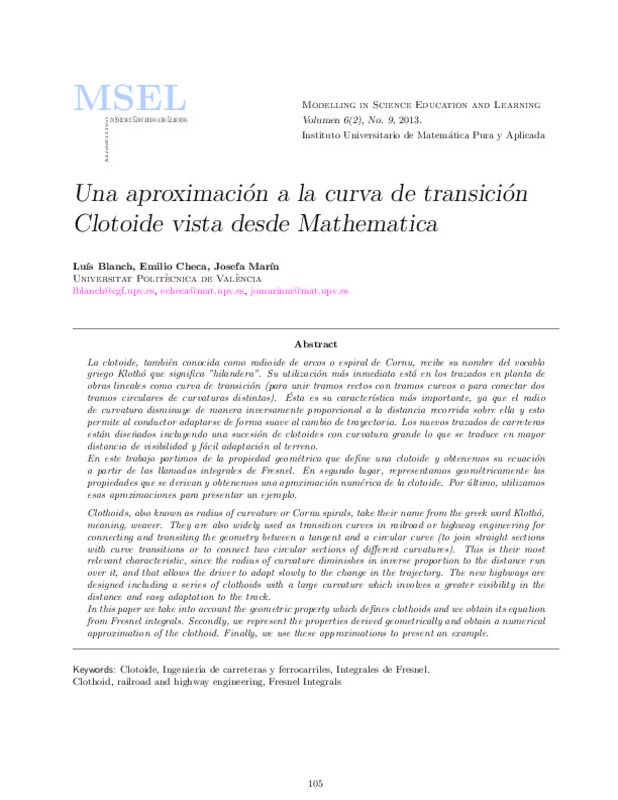JavaScript is disabled for your browser. Some features of this site may not work without it.
Buscar en RiuNet
Listar
Mi cuenta
Estadísticas
Ayuda RiuNet
Admin. UPV
Una aproximación a la curva de transición Clotoide vista desde Mathematica
Mostrar el registro sencillo del ítem
Ficheros en el ítem
| dc.contributor.author | Blanch, Luís
|
es_ES |
| dc.contributor.author | Checa, Emilio
|
es_ES |
| dc.contributor.author | Marín, Josefa
|
es_ES |
| dc.date.accessioned | 2018-04-23T07:10:17Z | |
| dc.date.available | 2018-04-23T07:10:17Z | |
| dc.date.issued | 2013-06-02 | |
| dc.identifier.uri | http://hdl.handle.net/10251/100862 | |
| dc.description.abstract | [EN] Clothoids, also known as radius of curvature or Cornu spirals, take their name from the greek word Klothó, meaning, weaver. They are also widely used as transition curves in railroad or highway engineering for connecting and transiting the geometry between a tangent and a circular curve (to join straight sections with curve transitions or to connect two circular sections of different curvatures). This is their most relevant characteristic, since the radius of curvature diminishes in inverse proportion to the distance run over it, and that allows the driver to adapt slowly to the change in the trajectory. The new highways are designed including a series of clothoids with a large curvature which involves a greater visibility in the distance and easy adaptation to the track. In this paper we take into account the geometric property which defines clothoids and we obtain its equation from Fresnel integrals. Secondly, we represent the properties derived geometrically and obtain a numerical approximation of the clothoid. Finally, we use these approximations to present an example. | es_ES |
| dc.description.abstract | [ES] La clotoide, también conocida como radioide de arcos o espiral de Cornu, recibe su nombre del vocablo griego Klothó que significa "hilandera". Su utilización más inmediata está en los trazados en planta de obras lineales como curva de transición (para unir tramos rectos con tramos curvos o para conectar dos tramos circulares de curvaturas distintas). Ésta es su característica más importante, ya que el radio de curvatura disminuye de manera inversamente proporcional a la distancia recorrida sobre ella y esto permite al conductor adaptarse de forma suave al cambio de trayectoria. Los nuevos trazados de carreteras están diseñados incluyendo una sucesión de clotoides con curvatura grande lo que se traduce en mayor distancia de visibilidad y fácil adaptación al terreno. En este trabajo partimos de la propiedad geométrica que define una clotoide y obtenemos su ecuación a partir de las llamadas integrales de Fresnel. En segundo lugar, representamos geométricamente las propiedades que se derivan y obtenemos una aproximación numérica de la clotoide. Por último, utilizamos esas aproximaciones para presentar un ejemplo. | es_ES |
| dc.language | Español | es_ES |
| dc.publisher | Universitat Politècnica de València | |
| dc.relation.ispartof | Modelling in Science Education and Learning | |
| dc.rights | Reconocimiento - No comercial (by-nc) | es_ES |
| dc.subject | Clotoide | es_ES |
| dc.subject | Ingeniería de carreteras y ferrocarriles | es_ES |
| dc.subject | Integrales de Fresnel | es_ES |
| dc.subject | Clothoid | es_ES |
| dc.subject | Railroad and highway engineering | es_ES |
| dc.subject | Fresnel Integrals | es_ES |
| dc.title | Una aproximación a la curva de transición Clotoide vista desde Mathematica | es_ES |
| dc.type | Artículo | es_ES |
| dc.date.updated | 2018-04-20T07:46:22Z | |
| dc.identifier.doi | 10.4995/msel.2013.1939 | |
| dc.rights.accessRights | Abierto | es_ES |
| dc.description.bibliographicCitation | Blanch, L.; Checa, E.; Marín, J. (2013). Una aproximación a la curva de transición Clotoide vista desde Mathematica. Modelling in Science Education and Learning. 6(2):105-119. https://doi.org/10.4995/msel.2013.1939 | es_ES |
| dc.description.accrualMethod | SWORD | es_ES |
| dc.relation.publisherversion | https://doi.org/10.4995/msel.2013.1939 | es_ES |
| dc.description.upvformatpinicio | 105 | es_ES |
| dc.description.upvformatpfin | 119 | es_ES |
| dc.type.version | info:eu-repo/semantics/publishedVersion | es_ES |
| dc.description.volume | 6 | |
| dc.description.issue | 2 | |
| dc.identifier.eissn | 1988-3145 | |
| dc.description.references | P. K. Kythe, P. Puri, M. R. Schäferkotter. Partial Differential Equations and Mathematica, CRC, 1997. | es_ES |








